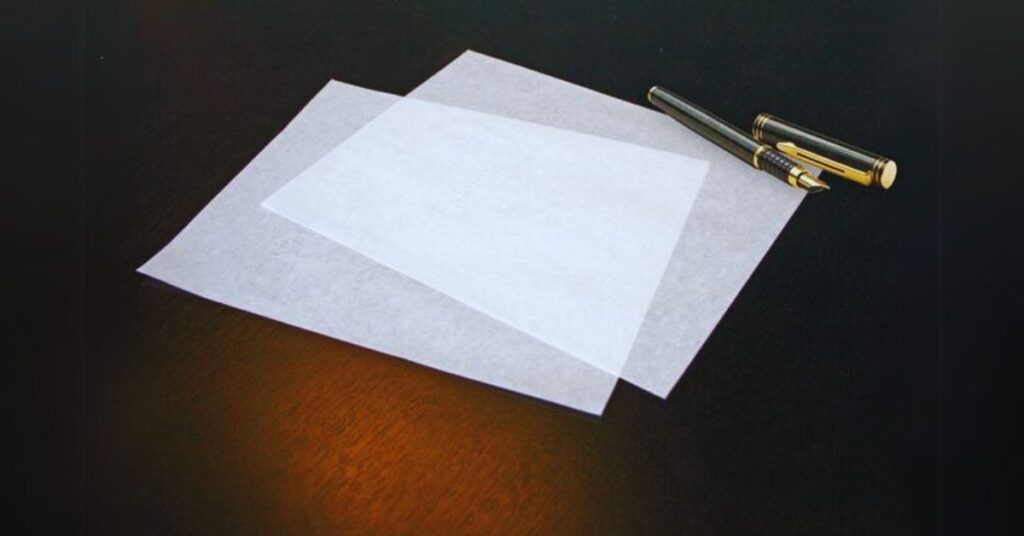Transparent onion skin paper is renowned for its resilience and gossamer thinness. Though it might be challenging to print on without particular considerations, it’s ideal for several applications, including calligraphy, origami, handicraft, and traditional animation.
This article covers everything you need about onionskin paper, including its properties, applications, and printing advice.
Onionskin paper, sometimes referred to as airmail or bible paper, gets its name from its fragile, translucent look. This fascinating paper is rife with amusing contradictions: it’s a pleasure to write on and excellent at retaining ink, but printing presents difficulties. It’s so thin and gossamer that it becomes limp under its weight, but it’s great at keeping precise folds.
Because of its special qualities, creative societies highly prize onionskin paper. It can be hard to locate and even harder to discover knowledge about how to use it effectively. It is also cloaked in mystery.
Onion Skin Typewriter Paper Online
The first task was to select a paper with heart and character. She recalled simpler days when it took courage to write a letter. She recalled the letters sent during times of conflict between lovers on opposite sides of the world. She investigated and found that the paper used was an obscure paper known as OnionSkin Paper, which is no longer produced.
Its mild translucency gives the impression that the paper absorbs an endless stream of consciousness.
This thin paper, made entirely of wood pulp, is surprisingly robust and does not bleed, making it suitable for fountain pens and paint.
This crisp paper gradually takes on a limp, almost cockled quality as the journal is used as if it were growing, changing, and alchemizing along the way with you.
What is Onion Skin Paper?
Writing paper made of onion skin is thin and translucent. It comes in ultra-light basis weights, such as 10 lb bond, and can be either white or yellow. Onion paper is remarkably sturdy for such a light paper since it has a high ratio of long cotton fibers and hydrated chemically treated wood pulp.
After being scaled using rosin, starch, or glue, it is plated or supercalendered to create a smooth, long-lasting surface.
Air-drying onion paper can also produce a cockle finish, which is somewhat wavy and uneven in look and feel because of the process.
When handling onion paper, its inherent waviness and irregularity create that mouthwatering crackling sound. Although it sounds unsettling, the cracking is good since it keeps the thin sheets from clinging to one another. Even though most onion skin sheets nowadays lack a cockle finish, this trait is highly favored in online forums.
What is Paper Onion Used for?

Paper onion has many applications, including:
- Creating duplicate copies of typewritten material
- Permanent records where low bulk is important
- Printing thick books that can become overly bulky, such as the bible and complete dictionaries
- Traditional cel animation
- Airmail correspondence
- Calligraphy
- Crafting, cardmaking, and scrapbooking
- Toy kites and paper airplanes
- Origami
- Confetti
- Creating frosted windows in model trains and craft projects
- Making lampshades and lanterns
Made In America
Eight book manufacturing businesses rejected our request to manufacture the journal in the United States. They asserted that onion skin typing paper needed to be more challenging and incompatible with their contemporary equipment. At that time, we discovered Anthony in Miami. Alongside his father and son, the three men used their hands and bookmaking equipment to construct these volumes from the turn of the century.
We have a lovely, heart-based relationship with the bookmakers and talk to them virtually every week. The love that goes into creating these books expresses this love. You can sense it, too.
Onion Skin Typing Paper Online
This week, we delved into one of the enormous paperwork boxes to process the Blue Jacket Collection. We discovered a lot of onion skin typing paper in this collection of documents. Soft and almost translucent, onion skin typing paper is thin enough to evoke the phrase “flimsy.” I asked the instructor about any potential additional considerations for preserving or archiving documents on this type of paper because this got me thinking.
You can’t have something flimsy in an archive collection, can you? He informed me that the processing notes must include no extra preservation instructions since onion skin paper is resilient and comparatively acid-free. I trusted him, but I couldn’t understand how a paper that seemed so insignificant could be strong enough not to need to be preserved in the future.
What Exactly is the Deal with Onionskin Paper?
It took a lot of work to locate information about onion skin paper; I needed help finding papers about preservation or even general paper discussions, so I turned to more mainstream sources to locate information about archival preservation. My normal resource for this type of material, the Northeast Document Conservation Center, was empty. I eventually found the information I needed on Conservation Online after being reminded of it by references on Wikipedia. Their description of onion skin paper, in my opinion, provides a reasonable explanation of why this paper is superior to what I had assumed due to its thinness and translucence:
“It is a thin, sturdy, lightweight paper that is typically almost translucent; it gets its name because it resembles the dry outer skin of an onion. It is utilized for airmail correspondence, permanent documents when low bulk is crucial, and the creation of duplicate copies of typewritten materials. Cotton fibers, chemically bleached wood pulps, or a combination are used to make it. The paper is scaled using glue, rosin, or starch and has long fibers. It is typically cockle-finished, supercalendered, or plated to a high finish.”
The lightweight yet sturdy nature of onion skin paper initially confused me. This set of characteristics makes it ideal for airmail, bibles, and other situations requiring durable paper with minimal mass. Making carbon copies in typewriters was the other principal application for onion skin paper, and its translucence also makes it an excellent tracing paper. In the conservation literature, “onion skin” and other words have been used interchangeably with “tracing paper,” according to the Journal of the American Institute of Conservation.

The majority of onion skin paper on the market today is either entirely cotton or at least 25% cotton, which provides, as the definition indicates, long fibers that explain the durability I discovered when I was forced to look around at manufacturer products due to the absence of information available on the subject. Although I could not locate any information regarding the precise cause of the near translucence, it stems from the supercalendering procedure, which involves rolling the paper between alternating fiber and chrome rollers.
Although I could not locate any information regarding the precise cause of the near translucence, it stems from the supercalendering procedure, which involves rolling the paper between alternating fiber and chrome rollers.
Regarding the original query that prompted me to conduct this investigation, The Papermill’s PDF on how to handle and care for onion skin paper merely advises taking extra precautions when the ink is drying on the paper right after printing and making sure the fibers are oriented correctly when bound in a book. The length of the fibers explains both the durability and the absence of acid, and John was right about the lack of preservation issue, as I had anticipated. I now better understand why this seemingly fragile paper endures and know more about paper in general.

